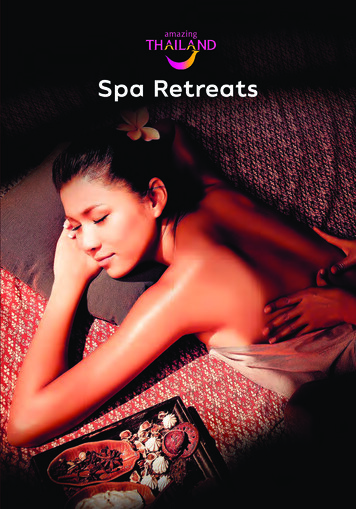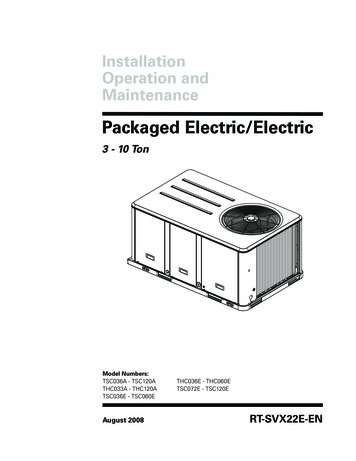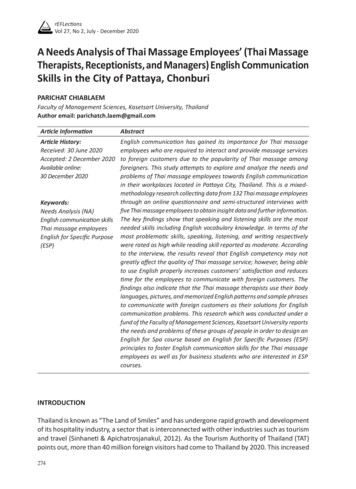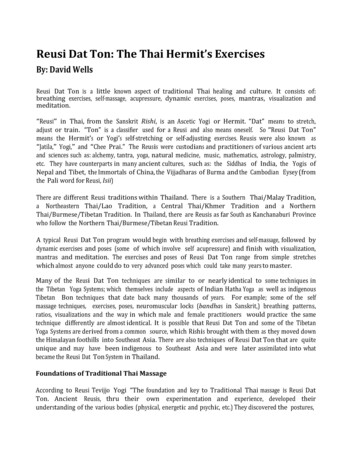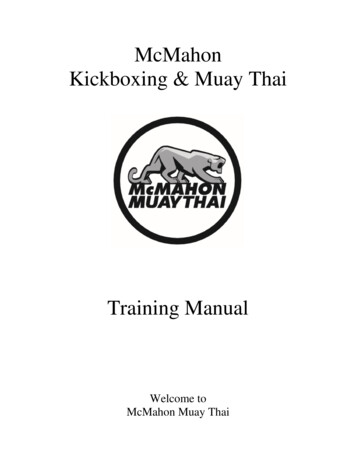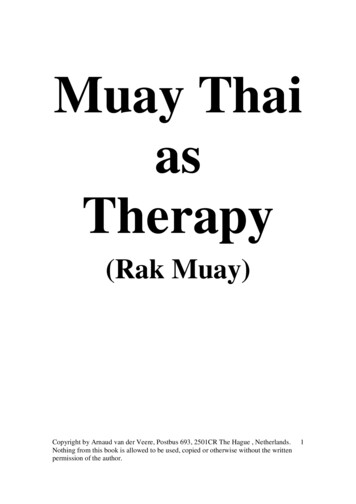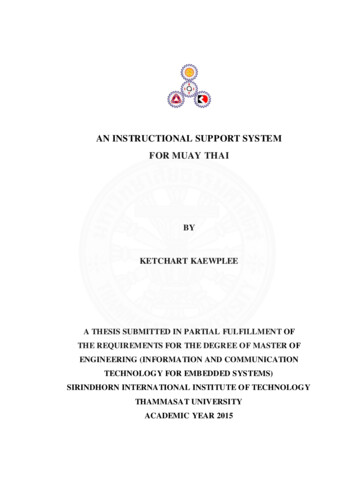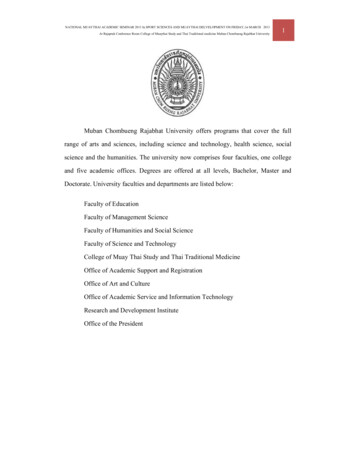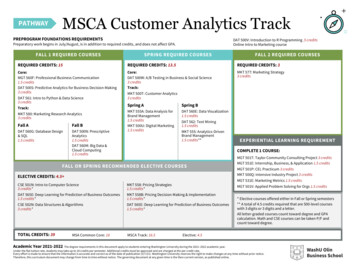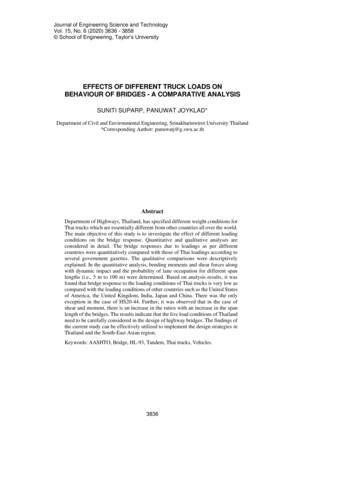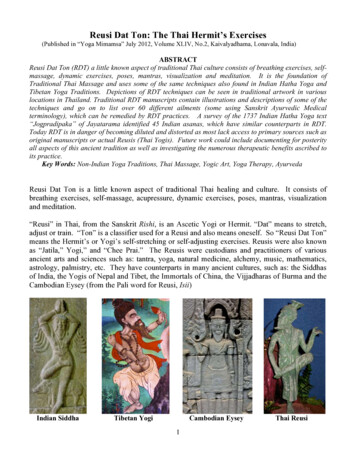
Transcription
Reusi Dat Ton: The Thai Hermit’s Exercises(Published in “Yoga Mimamsa” July 2012, Volume XLIV, No.2, Kaivalyadhama, Lonavala, India)ABSTRACTReusi Dat Ton (RDT) a little known aspect of traditional Thai culture consists of breathing exercises, selfmassage, dynamic exercises, poses, mantras, visualization and meditation. It is the foundation ofTraditional Thai Massage and uses some of the same techniques also found in Indian Hatha Yoga andTibetan Yoga Traditions. Depictions of RDT techniques can be seen in traditional artwork in variouslocations in Thailand. Traditional RDT manuscripts contain illustrations and descriptions of some of thetechniques and go on to list over 60 different ailments (some using Sanskrit Ayurvedic Medicalterminology), which can be remedied by RDT practices. A survey of the 1737 Indian Hatha Yoga text“Jogpradipaka” of Jayatarama identified 45 Indian asanas, which have similar counterparts in RDT.Today RDT is in danger of becoming diluted and distorted as most lack access to primary sources such asoriginal manuscripts or actual Reusis (Thai Yogis). Future work could include documenting for posterityall aspects of this ancient tradition as well as investigating the numerous therapeutic benefits ascribed toits practice.Key Words: Non-Indian Yoga Traditions, Thai Massage, Yogic Art, Yoga Therapy, AyurvedaReusi Dat Ton is a little known aspect of traditional Thai healing and culture. It consists ofbreathing exercises, self-massage, acupressure, dynamic exercises, poses, mantras, visualizationand meditation.“Reusi” in Thai, from the Sanskrit Rishi, is an Ascetic Yogi or Hermit. “Dat” means to stretch,adjust or train. “Ton” is a classifier used for a Reusi and also means oneself. So “Reusi Dat Ton”means the Hermit’s or Yogi’s self-stretching or self-adjusting exercises. Reusis were also knownas “Jatila,” Yogi,” and “Chee Prai.” The Reusis were custodians and practitioners of variousancient arts and sciences such as: tantra, yoga, natural medicine, alchemy, music, mathematics,astrology, palmistry, etc. They have counterparts in many ancient cultures, such as: the Siddhasof India, the Yogis of Nepal and Tibet, the Immortals of China, the Vijjadharas of Burma and theCambodian Eysey (from the Pali word for Reusi, Isii)Indian SiddhaTibetan YogiCambodian Eysey1Thai Reusi
There are different Reusi traditions within Thailand. There is a Southern Thai/Malay Tradition, aNortheastern Thai/Lao Tradition, a Central Thai/Khmer Tradition and a NorthernThai/Burmese/Tibetan Tradition. In Thailand, there are Reusis as far South as KanchanaburiProvince who follow the Northern Thai/Burmese/Tibetan Reusi Tradition.A typical Reusi Dat Ton program would begin with breathing exercises and self-massage,followed by dynamic exercises and poses (some of which involve self acupressure) and finishwith visualization, mantras and meditation. The exercises and poses of Reusi Dat Ton range fromsimple stretches which almost anyone could do, to very advanced poses which could take manyyears to master.Some of the Reusi Dat Ton techniques are similar to or nearly identical to some techniques invarious Tibetan Yoga Systems, particularly “Yantra Yoga,” “Kum Nye” and the Tibetan YogaFrescoes from the Lukhang Temple behind the Potala Palace in Lhasa Tibet. (See Norbu, Tulkuand Baker) For example; some of the self massage techniques, exercises, poses, neuromuscularlocks (bandhas in Sanskrit,) breathing patterns, ratios, visualizations and the way in which maleand female practitioners would practice the same technique differently are almost identical. It ispossible that Reusi Dat Ton and some of the Tibetan Yoga Systems are derived from a commonsource, which Rishis brought with them as they moved down the Himalayan foothills intoSoutheast Asia.Foundations of Traditional Thai MassageTraditional Thai Massage Charts at Wat Po, BangkokAccording to Suklavastra Yogi “The foundation and key to Traditional Thai massage is ReusiDat Ton. Ancient Reusis, through their own experimentation and experience, developed their2
understanding of the various bodies (physical, energetic and psychic, etc.) They discovered thepostures, channels, points, the winds and wind gates within themselves. Later it was realized thatthese techniques could be adapted and applied to others for their healing benefit, which is howThai massage was developed. So, in order to really understand Thai massage, as a practitioner,one should have a foundation in Reusi Dat Ton and be able to experience it within oneself andthen apply it to others. It is not only the roots of Thai massage but it also unlocks the method fortreating oneself and maintaining one's own health.” (SuklavastraYogi)It is also interesting to note that there are similarities between certain Thai massage techniquesand some of the Indian Hatha Yoga therapeutic warming up exercises (the Pawanmuktasana orwind liberating and energy freeing techniques.) There is even an advanced Hatha Yoga pose,Poorna Matsyendrasana, which compresses the femoral artery and produces the same effect as“opening the wind gate” in Thai massage. (Saraswati)Reusi Dat Ton in Traditional ArtIn Northeast Thailand, in Buriram province atop an extinct volcano sits the Ancient Khmertemple of Prasat Phnom Rung. Built between 900 and 1200AD, this temple is dedicated to theHindu God Shiva. The pediment over the eastern doorway features a sculpture of an avatar ofShiva in the form of Yogadaksinamurti. According to the Department of Fine Arts“Yogadaksinamurti means Shiva in the form of the supreme ascetic, the one who gives andmaintains wisdom, perception, concentration, asceticism, philosophy, music and the ability toheal disease with sacred chants.” Here “Shiva is dressed as a hermit with crowned headdressholding a rosary in his right hand, seated in the lalitasana position surrounded by followers.There are figures below him that represent the sick and wounded.” (Department of Fine Arts).All over the temple one can see additional carvings of Reusis engaged in various activities. Inone carving of the “Five Yogis” (or Reusis) the central figure is the God Shiva in his incarnationas Nagulisa, the founder of the Pasupata sect of Shivaite Hinduism. The four yogis on his sidesare followers of this Pasupata sect, which is still active today in Nepal.Prasat Phnom RungYogadaksinamurti3Pasupata Temple, Nepal
In 1767, invading Burmese armies destroyed the old Thai capital of Ayutthaya. Soon after hiscoronation in 1782, the Thai King Rama I established a new capital in what is today Bangkok. Heinitiated a project to revive the Thai culture after the disaster of Ayutthaya. An old temple WatPotharam, (popularly known as “Wat Po,”) was chosen to become the site of a new Royal templeand formally renamed Wat Phra Chetuphon. Beginning in 1789, a renovation and expansionproject was begun on the temple. King Rama I also initiated a program to restore and preserve allbranches of ancient Thai arts and sciences including: medicine, astrology, religion and literature.As part of this project, medical texts from across the kingdom were collected and brought to bestored at Wat Po. The King also ordered the creation of a set of clay Reusi statues depictingvarious Reusi Dat Ton techniques.This restoration project was continued by the Kings Rama II and Rama III. As part of this work,scholars compiled important texts on various ancient arts and sciences and created authoritativetextbooks for each of these fields. In 1832, a project to etch the medical texts into marble tabletswas begun. Medical theories regarding the origin and treatment of disease, massage charts andover 1000 herbal formulas were all recorded on the marble tablets. Gardens of medicinal herbswere also planted on the temple grounds. Thus, Wat Po was to become “a seat of learning for allclasses of people in all walks of life” which would “expound all braches of traditional knowledgeboth religious and secular,” and serve as “an open university” of traditional Thai culture with a“library of stone.” (Griswold, 319-321)Wat PoEngraved Medical TabletsBy 1836, the clay Reusi Dat Ton statues created by order of King Rama I had deteriorated. Toreplace these, King Rama III commissioned the creation of 80 new Reusi Dat Ton statues. Eachstatue depicted a different Reusi performing a specific Reusi Dat Ton technique. For each statuethere was a corresponding marble tablet upon which was etched a poem describing the techniqueand it’s curative effect. These poems were composed by various important personalities of theday. Princes, monks, government officials, physicians, poets, and even the King himselfcontributed verses. The original plan was to cast the statues with an alloy of zinc and tin, butunfortunately only the more perishable material stucco was used. The statues were then paintedand housed in special pavilions. Over the years most of the original statues have been lost ordestroyed. Today only about 20 remain and these are displayed upon two small “Hermit’s4
Mountains” near the Southern entrance of Wat Po. The marble tablets have been separated fromtheir corresponding statues and are now stored in the pavilion Sala Rai.“Hermit’s Mountain” Wat PoReusi Dat Ton Statues at Wat PoBeginning in 2009, the casting of metal Reusi Dat Ton statues was begun. These new statues aregradually appearing in and around the Wat Po Massage School near the Eastern entrance of WatPo. So now after almost 200 years, Wat Po will soon finally have it’s complete set of 80 metalReusi Dat Ton statues as originally envisioned by King Rama III.Textual Sources of Reusi Dat TonReusis from Prasat Phnom RungTraditional Thai ManuscriptWe may never know what, if any Ancient texts on Reusi Dat Ton may have existed and were lostwhen the invading Burmese armies destroyed the old Thai capital of Ayutthaya in 1767. Today,the closest thing to an original source text on Reusi Dat Ton is an 1838 manuscript commissionedby Rama III entitled The Book of Eighty Rishis Performing Posture Exercises to Cure VariousAilments. Like other manuscripts of the time, this text was printed on accordion like folded blackpaper, known in Thai as “Khoi.” This text, popularly known as the Samut Thai Kao features linedrawings of the 80 Wat Po Reusi Dat Ton statues along with their accompanying poems. In theintroduction, it states that Reusi Dat Ton is a “ system of posture exercises invented by expertsto cure ailments and make them vanish away.” (Griswold, 321) This text is housed in the5
National Library in Bangkok. There are also other editions of this text housed in museums andprivate collections as well.The Samut Thai Kao seems to follow an old tradition also found in ancient Indian, Nepali andTibetan Yoga manuscripts that list 80 to 84 different techniques. The Samut Thai Kao is,however, only a partial collection of all the various Reusi Dat Ton techniques. A 1958 Wat Popublication, The Book of Medicine includes a section on Reusi Dat Ton. While it contains versesbased upon the poems at Wat Po, many of the accompanying illustrations depict completelydifferent techniques.In the Southern Thai town of Songkhla, on the temple grounds of Wat Machimawat is a pavilionknown as the “Sala Reusi Dat Ton.” High up on the inside walls of this pavilion is a mural whichdepicts 40 of the Reusi Dat Ton techniques along with the accompanying poems from the SamutThai Kao.Reusi Dat Ton Mural at Wat MachimawatThere is a special section devoted to Thai Medical history at the Mahidol University’s SirirajMedical Museum on the Bangkok Noi campus in Bangkok. There one can view a Reusi Dat Tondisplay featuring small painted wood Reusi figures that depict over 60 different Reusi Dat Tontechniques. This display is based upon the 1958 Wat Po text The Book of Medicine.In Nonthaburi, on the Ministry of Public Health Campus at the Institute of Thai TraditionalMedicine, there is the Thai Traditional Medicine Museum. Inside the museum is a small displayof Reusi Dat Ton statues. Outside the museum is an artificial mountain upon which have beenplaced various Reusi statues demonstrating Reusi Dat Ton techniques. Within the mountain is the“Hermit’s Cave” which houses numerous small Reusi statues also depicting Reusi Dat Tontechniques. These statues depict techniques from both the Samut Thai Kao and The Book ofMedicine.6
On the outskirts of Bangkok, in the town of Samut Prakan, is the cultural park, the Ancient Cityor “Muang Boran.” One of the many attractions is a “Sala of 80 Yogi” which features 80 lifesized Reusi statues illustrating various Reusi Dat Ton techniques. There are even depictions ofReusi Dat Ton techniques not found in either of the two Wat Po texts. While most of thesestatues are fairly accurate depictions of Reusi Dat Ton techniques, a few actually show IndianHatha Yoga techniques, which are not part of the Reusi Dat Ton system.Students of Reusi Dat Ton should bear in mind that while some of the Reusi Dat Don statues,drawings, paintings and poems are beautiful works of art, they were created by artists who werenot necessarily all practitioners of Reusi Dat Ton. In fact, a number of images do not illustrate theactual techniques entirely accurately. Even in 1836, there was some uncertainty as to whichtechnique produced which effect and some poems were used for more than one technique.Therefore, students of Reusi Dat Ton should also seek out living teachers who have learned fromauthentic sources such as actual Reusis, who can teach the techniques in their authentic form.There are also additional Reusi Dat Ton techniques practiced by Reusis today, which are notfound in any text, nor depicted in any sculpture or paintings. These are also traditionaltechniques, which have been passed down from teacher to student over the centuries. There areclose to 300 different exercises and poses, including variations, in the entire Reusi Dat Tonsystem.“Hermit’s Mountain” at The Thai Ministry of Public HealthReusi Statue at Ancient CityThe Benefits of Reusi Dat TonIn both the Samut Thai Kao and The Book of Medicine, the texts not only describe the techniques,but also ascribe a therapeutic benefit to each pose or exercise. Some poems describe specificailments while others use Sanskrit Ayurvedic medical terminology.Some of the ailments mentioned include; abdominal discomfort and pain, arm discomfort, backpain, bleeding, blurred vision, chest congestion, chest discomfort and pain, chin trouble, chronicdisease, chronic muscular discomfort, congestion, convulsions, dizziness and vertigo, dyspepsia,7
facial paralysis, fainting, foot cramps, pain and numbness, gas pain, generalized weakness,generalized sharp pain, headache and migraine, hand discomfort, cramps and numbness, heel andankle joint pain, hemorrhoids, hip joint problems, joint pain, knee pain and weakness, lack ofalertness, leg discomfort, pain and weakness, lockjaw, low back pain, lumbar pain, muscularcramps and stiffness, nasal bleeding, nausea, neck pain, numbness, pelvic pain, penis and urethraproblems, scrotal distention, secretion in throat, shoulder and scapula discomfort and pain, stiffneck, thigh discomfort, throat problems, tongue trouble, uvula spasm, vertigo, waist trouble, wristtrouble, vomiting, and waist discomfort.Some of the Ayurvedic disorders described in the texts include; Wata (Vata in Sanskrit) in thehead causing problems in meditation, severe Wata disease, Wata in the hands and feet, Wata inthe head, nose and shoulder, Wata in the thigh, Wata in the scrotum, Wata in the urethra, Watacausing knee, leg and chest spasms, Wata causing blurred vision, Sannipat (a very serious anddifficult to treat condition due to the simultaneous imbalance of Water, Fire and Wind Elementswhich may also involve a toxic fever) an excess of Water Dhatu (possibly plasma or lymphfluids,) and “Wind” in the stomach. Other benefits described in the old texts include; increasedlongevity and opening all of the “Sen” (There are various types of “Sen” or channels inTraditional Thai Medicine. There are Gross Earth Physical “Sen” such as Blood Vessels. Thereare also more Subtle “Sen” such as channels of Bioenergy flow within the Subtle Body, known as“Nadis” in Sanskrit. In addition, there are also “Sen” as channels of the Mind.)For Shoulder DiscomfortFor Foot Cramps & LongevityFor HeadacheIn recent years, the Thai Ministry of Public Health has published several books on Reusi Dat Ton.According these modern texts, some of the benefits of Reusi Dat Ton practice include; improvedagility and muscle coordination, increased joint mobility, greater range of motion, bettercirculation, improved respiration improved digestion, assimilation and elimination, detoxification,stronger immunity, reduced stress and anxiety, greater relaxation, improved concentration andmeditation, oxygen therapy to the cells, pain relief, slowing of degenerative disease and greaterlongevity. (Subcharoen, 5-7)8
A recent study at Naresuan University in Phitsanulok, Thailand, found that after one month ofregular Reusi Dat Ton practice there was an improvement in anaerobic exercise performance insedentary females. (Weerapong et al, 205)Thai Reusi Dat Ton and Indian Hatha YogaA survey of the traditional Indian Hatha Yoga text Jogapradipaka of Jayatarama from 1737ADidentified the following 45 Indian asanas as having similar or identical counterparts in Thai ReusiDat Ton; Svastikasana, Padmasana, Netiasana, Udaraasana, Purvasana, Pascimatanasana,Suryasana, Gorakhajaliasana, Anasuyasana, Machendrasana, Mahamudrasana, Jonimudrasana,Sivasana, Makadasana, Bhadragorakhasana, Cakriasana, Atamaramasana, Gohiasana,Bhindokasana, Andhasana, Vijogasana, Jonisana, Bhagasana, Rudrasana, Machindrasana acaukasana,Gvalipauasana,Gopicandasana, Bharathariasana, Anjanasana, Savitriasana, Garudasana, Sukadevasana,Naradasana, Narasimghasana, Kapilasana, Yatiasana, Vrhaspatiasana, Parvatiasana,Siddhaharataliasana, Anilasana, Parasaramasana and Siddhasana. To date over 200 differentIndian Hatha Yoga techniques have been identified which have similar or identical counterpartsin Thai Reusi Dat Ton.Some of the Reusi Dat Ton poses which have similar counterparts in Hatha Yoga9
One unique feature of Reusi Dat Ton is the absence of Viparitakarani (Inversions) such asShirshasana (Headstand), Sarvangasana (Shoulderstand.) Reusi Dat Ton also has no equivalentsto Mayurasana (Peacock) or Bakasana (Crow). In Hatha Yoga both men and women use the leftheel to press the perineum in Siddhasana (Adepts Pose), while in Reusi Dat Ton, men use theright heel and women use the left. Reusi Dat Ton includes a series of “Joint Mobilization”exercises, many of which are very similar or identical to the Pawanmuktasana (Joint Looseningand Energy Freeing Exercises) taught by the Bihar School of Yoga in Northeast India. (Saraswati)Reusi Dat Ton also includes a system of self-massage, which is typically done prior to theexercises.Both Hatha Yoga and Reusi Dat Ton practice forms of Surya and Chandra Bhedana Pranayama(Solar and Lunar Breathing.) However in Hatha Yoga men and women both use the right handwhen practicing Pranayama (Breathing Exercises), while in Reusi Dat Ton men use the righthand and women use the left. Both use Ashwini Mudra (Anal Lock) and Jivha Bandha (TongueLock.) However, Reusi Dat Ton has no counterparts to Uddiyana Bandha (Abdominal Lock) orJalandhara Bandha (Throat Lock.)In Traditional Indian Hatha Yoga one will generally maintain an Asana for a few minutes. Incontrast, Reusi Dat Ton tends to be more dynamic. Generally, one will inhale while going into thepose, hold the pose for several breaths, and then exhale when coming out of the pose. This isdone to encourage the strong, healthy flow of Prana thru the Nadis (or Loam thru the Sen in Thai)Reusi Dat Ton TodayToday in Thailand, Reusi Dat Ton is being used in various ways. Some practice Reusi Dat Tonposes and exercises as a way to improve and maintain overall health, in much the same way asHatha Yoga and Chi Gong are used today. Others such as Ajan Pisit Benjamongkonware ofPisit’s Massage School in Bangkok use Reusi Dat Ton in combination with traditional ThaiMassage techniques as a system of therapy. They will use specific techniques for specificailments, rather like an ancient system of rehabilitation similar to modern day Chiropractic andPhysical Therapy. Others consider the energetic effects with the aim of facilitating the normalhealthy flow of bioenergy through the “Sen” or energy channels of the subtle body. There arealso a few remaining Reusis who still use Reusi Dat Ton in the traditional way as part of theirpersonal meditation and spiritual practice.10
Reusis at Wat Pra Kaew, BangkokNew Reusi Dat Ton Statue with Poem, Wat PoThe Institute of Thai Traditional Medicine at the Ministry of Public Health requires all theirstudents of Thai Massage and Thai Traditional Medicine to attend Reusi Dat Ton classes as partof their curriculum. In these classes, students learn some of the self-massage techniques as well as15 poses and exercises. While based on Reusi Dat Ton, these 15 techniques are actually newlycreated modifications thought to be safe and easily practiced by anyone. In Bangkok, The Wat PoSchool of Traditional Medicine offers a formal Reusi Dat Ton certification course in whichstudents learn 18 of the poses and exercises. The Massage School Chiang Mai offers a formalReusi Dat Ton certificate course, which is accredited by the Thai Ministry of Education. Theircourse is based on the same 15 poses and exercises as taught by the Ministry of Public Health.There are also a number of other places offering Reusi Dat Ton classes. Most of these programsteach either one or a combination of both of the two different programs, as taught by the Ministryof Public Health and Wat Po. There are also a number of commercially available Reusi Dat Tonbooks and videos.Today in Thailand, there are a dwindling number of true Reusis and few young people areinterested in learning the traditional arts and sciences in their authentic forms. Much of thetraditional knowledge of the Reusi traditions is in danger of being lost. Nowadays, most modernday students and teachers of Reusi Dat Ton have learned from second or third hand sources suchas commercially available books, videos and classes. They have not had access to primary sourcessuch as actual Reusis or even the Samut Thai Kao. If this trend continues, there is a danger ofReusi Dat Ton becoming diluted and distorted like Hatha Yoga has become in today’s popularculture. Today we may well be seeing the last generation of teachers with an actual living link tothe ancient traditions of the past and who are able to transmit the authentic teachings of Reusi DatTon. Serious students of Reusi Dat Ton would do well to seek out actual Reusis who havethemselves learned from older Reusis who serve as a living link in the lineage of this ancienttradition.Possible Future ResearchA possible research project would be to seek out Reusis and traditional healers across Thailand.One would then learn as much as possible about Reusi Dat Ton from them and compile it. This11
way the authentic teachings of this ancient tradition would not be lost in case these people diewithout being able to pass their knowledge on to the next generation. It could also be well worthinvestigating the many claims about the therapeutic effects attributed to Reusi Dat Ton practicesin the old texts.ReferencesEnglish LanguageBaker, Ian A. and Thomas Laird. (2000). “The Dali Lama’s Secret Temple: Tantric Wall Paintings fromTibet.” Thames & Hudson Ltd., London, UK.Buhnemann, Gudrun. (2007). “Eighty-Four Asanas in Yoga: A Survey of Traditions.” (Contains theJogapradipika of Jayatarama). D. K. Printworld, New Delhi, India.Chokevivat, Vichai and Chuthaputti, Anchalee. (2005). “The Role of Thai Traditional Medicine in HealthPromotion.” Thai Ministry of Public Health, Nonthaburi, Thailand.Chuthaputti, Anchalee. (2007). “National Traditional System of Medicine Recognized by the ThaiGovernment.” Thai Ministry of Public Health, Nonthaburi, Thailand.Covington, Laura. (2010). “Interview with a Reusi.” (Interview with Reusi Tevijjo Yogi). Bodhi TreeLearning Center. Richmond, USA.Department of Fine Arts. “Phnom Rung Historical Park Visitors Guide.” (And displays in the PhnomRung Museum.) Department of Fine Arts, Buriram, Thailand.Evans-Wentz, W. Y. (2006). “Tibetan Yoga and Secret Doctrines.” Pilgrims Publishing, Varanasi, India.Gharote, M. L. (Editor). (2006). “Encyclopaedia of Traditional Asanas.” The Lonavala Yoga Institute.Lonavala, India.Ginsburg, Henry. (2000). “Thai Art and Culture: Historic Manuscripts from Western Collections.”University of Hawaii, Honolulu, USA.Griswold, A.B. (1965). “The Rishis of Wat Po.” In Felicitation Volumes of Southeast Asian StudiesPresented to His Highness Prince Dhaninivat Kromamun Bidyalabh Brindhyakorn. The Siam Society,Bangkok, Thailand.H.H. Prince Dhani Nivat, “The Inscriptions of Wat Phra Jetubon,” Journal of the Siam Society. Vol. 26,Pt. 2. The Siam Society, Bangkok, Thailand.Hofbauer, Rudolf. “A Medical Retrospect of Thailand.” In Journal of the Thailand Research Society, 34:183-200. Thailand Research Society, Bangkok, Thailand.Linrothe, Rob, (Editor). (2006). “Holy Madness: Portraits of Tantric Siddhas.” Rubin Museum of Art andSerindia Publications. New York and Chicago, USA.Miao, Yuan. (2002). “Dancing on Rooftops with Dragons: The Yoga of Joy.” The Philosophical ResearchSociety, Los Angeles, USA.Massage School of Chiang Mai. (2006). Yogi Exercise “Lue Sri Dadton” Student Handbook. MassageSchool of Chiang Mai, Chiang Mai, Thailand.Matics, Kathleen Isabelle. (1978). An Historical Analysis of the Fine Arts at Wat Phra Chetuphon: ARepository of Ratanakosin Artistic Heritage, PhD Dissertation, New York University, New York, USA.Matics, K.I. (1977). “Medical Arts at Wat Pha Chetuphon: Various Rishi Statues.” In Journal of the SiamSociety, 65:2: 2: 145-152. The Siam Society, Bangkok, Thailand.Norbu, Chogyal Namkhai. (2008). “Yantra Yoga: The Tibetan Yoga of Movement.” Snow LionPublications, Ithaca, USA.Salguero, C. Pierce, (2007). “Traditional Thai Medicine: Buddhism, Animism and Ayurveda.” HohmPress, Prescott, USA.Saraswati, Swami Satyananda. (2006). “Asana, Pranayama, Mudra, Bandha.” Bihar School of Yoga,Yoga Publications Trust, Munger, India.12
Schoeppl, Adolf. (1981). Textbook of Thai Traditional Manipulative Medicine, MPH Thesis, MahidolUniversity, Bangkok, Thailand.Sheposh, Joel. (2006). Reusi Dat Ton: Thai Style Exercises, Tao Mt., Charlottesville, USA.Subcharoen, Pennapa and Deewised Kunchana, (Editors). (1995). “The Hermits Art of Contorting: ThaiTraditional Medicine.” The National Institute of Thai Traditional Medicine, Nontaburi, Thailand.Suklavastra Yogi. Personal Communication. Bangkok and Chiang Mai, Thailand.Tulku, Tarthang. (1978). “Kum Nye Relaxation: Parts 1and 2.” Dharma Publishing, Berkeley, USA.Tulku, Tarthang. (2003). “Tibetan Relaxation: Kum Nye Massage and Movement.” Duncan BairdPublications, London, UK.Venerable Dhammasaro Bhikkhu. “Textbook of Basic Physical Training- Hermit Style (Rishi).” Wat Po.Bangkok, Thailand.Wat Po Thai Traditional Medical School, Ruesi Dat Ton; Student Handbook. Wat Po. Bangkok, Thailand.White, David Gordon. (1996). “The Alchemical Body: Siddha Traditions in Medieval India.” Universityof Chicago Press, Chicago, USA.Thai LanguageAjan Pisit Benjamongkonware. (2007). “Twenty One Self Stretching Exercises (21 Ta Dat Ton).” VillageDoctor Press, Bangkok, Thailand.Ajan Pisit Benjamongkonware. Personal Communication. Pisit’s Massage School, Bangkok, Thailand,Ajan Kong Kaew Veera Prajak (Professor of Ancient Languages). Personal Communication. The AncientManuscript and Inscription Department, National Library, Bangkok, Thailand.Chaya, Ooh E. (2006). “Thai Massage, Reusi Dat Ton: Therapy for Illness and Relaxation, (Nuat Thai,Reusi Dat Ton: Bam Bat Rok Pai Klie Klieat).” Pi Rim Press, Bangkok, Thailand.Karen Reusi. Personal Communication via Dr. Robert Steinmetz of Wildlife Fund Thailand. Thung YaiNational Park in Kanchanaburi Province, Thailand,Mr. Kayat, (Editor). (1995). “Eighty Poses of Reusi Dat Ton, Wat Po (80 Ta Bat Reusi Dat Ton, WatPo).” Pee Wa Tin Press, Bangkok, Thailand.Mulaniti Health Center. (1994). “41 Poses, The Art of Self Massage for Health, (41 Ta, Sinlaba Gan NuatDon Eng Pua Sukapap).” Mulaniti Health Center, Bangkok, Thailand.Patanagit, Arun Rawee. (1994). “Body Exercise, Thai Style: Reusi Dat Ton, (Gan Brehan Rang Gie BapThai: Chut Reusi Dat Ton).” Petchkarat Press. Bangkok, Thailand.Saw Pai Noie. (2001). “Lang Neua Chop Lang Ya.” Sai Ton Press, Bangkok, Thailand.Sela Noie, Laeiat. (2000). “Amazing Thai Heritage: Reusi Dat Ton.” Dok Ya Press, Bangkok, Thailand.Subcharoen, Pennapa (Editor). (2004). “Handbook of Thai Style Exercise: 15 Basic Reusi Dat Ton Poses,(Ku Mu Gie Brehan Bap Thai Reusi Dat Ton 15 Ta).” Thai Traditional Medicine DevelopmentFoundation, Bangkok, Thailand.Subcharoen, Pennapa (Editor). (2006). “One Hundred Twenty Seven Thai Style Exercises, Reusi Dat Ton(127 Ta Gie Brehan Bap Thai, Reusi Dat Ton).” Thai Traditional Medicine Development Foundation,Bangkok, Thailand.Various authors commissioned by King Rama III. (1838). “The Book of Eighty Rishis PerformingPosture Exercises to Cure Various Ailments (Samut Rup Reusi Dat Ton Kae Rok Tang Tang Baet SipRup).” (Also known as Samut Thai Kao) Housed in the National Library Bangkok, Thailand,Wat Po Thai Traditional Medicine School. (1990). “Reusi Dat Ton Handbook (Dam Ra Reusi Dat TonWat Po).” (Reproductions from the original Samut Thai Kao). Wat Po Press, Bangkok, Thailand.Wat Po Thai Traditional Medicine School. (1958). “The Book Of Medicine (Dam Ra Ya).” (Contains aReusi Dat Ton section based on the same verses as the 1838 manuscript, Samut Thai Kao, but withcompletely di
ancient arts and sciences such as: tantra, yoga, natural medicine, alchemy, music, mathematics, astrology, palmistry, etc. They have counterparts in many ancient cultures, such as: the Siddhas of India, the Yogis of Nepal and Tibet, the Immortals of China, the Vijjadharas of Burma and the Cambodian Eysey (from the Pali word for Reusi, Isii)
